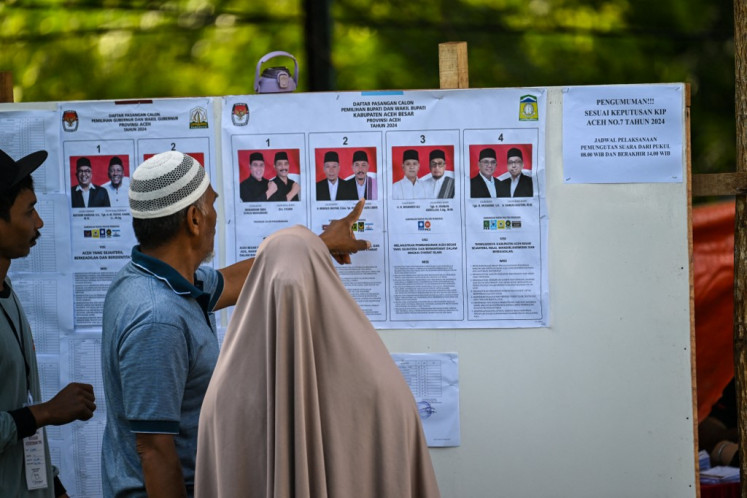Popular Reads
Top Results
Can't find what you're looking for?
View all search resultsPopular Reads
Top Results
Can't find what you're looking for?
View all search resultsCelebrating the life of Hazel Chung
The President and I: Hazel Chung (left) poses with Sukarno, Indonesia's first president known for his ardent devotion to the arts
Change text size
Gift Premium Articles
to Anyone
T
he President and I: Hazel Chung (left) poses with Sukarno, Indonesia's first president known for his ardent devotion to the arts. (Courtesy of Made Mantle Hood)
Scores of prominent figures of the Balinese dancing scene pay tribute to an old friend from a faraway land who has dedicated her life to introducing the island’s traditional dances to a broader audience.
Professor Made Bandem, 74, invited American dancer Hazel Chung, 85, onto the stage and convinced her to dance with him.
The audience broke into loud applause as the two elderly yet energetic dancers performed the Baris warrior dance.
The performance was reminiscent of an episode that took place some 60 years ago, when they performed the same dance at a temple festival in Celuk village, Gianyar regency, Bali.
At that time, Bandem was a teenage boy learning dances from his father, the famous I Made Keredek of Singapadu, while Chung was an accomplished ballet dancer studying Baris from dance maestro I Nyoman Kakul.
It was a fateful performance that bound their lives together.
Bandem would later study in the United States under the tutelage of Chung’s late husband, noted ethnomusicologist and gamelan (Javanese traditional orchestra) lover professor Mantle Hood, before carving an illustrious career as one of Bali’s most influential cultural scholars.
Chung, having mastered Balinese and Javanese classical dances, would return to the US and dedicated her life teaching hundreds of university students about the mesmerizing beauty of Indonesia’s traditional performing arts.
She also played a pivotal role in paving the way for Balinese artists to study at prestigious universities in the US, an opportunity that provided them with a valuable academic experience as well as an international network.
Most of them later became important figures in the preservation and advancement of Bali’s traditional arts. Some, such as Wayan Dibia, Nyoman Catra, Nyoman Windha, Ketut Gde Asnawa and Nyoman Wenten, were sitting in the front row with a gleeful smile on their faces that evening as Bandem and Chung ended their rendition of the warrior dance with a comedic twist.
The performance was one of many warm moments of the event, A Tribute to Hazel Chung: Pioneer of Ethnic Dance, held on the evening of July 3. It was organized by Chung’s family and friends in Bali to celebrate her life and contribution to the world of art.
Protege: Hazel Chung (left) had the opportunity to study under some of the island's most illustrious dancers. Here she is pictured learning the Legong dance from the dance maestro Mario (I Ketut Maria). (Courtesy of Made Mantle Hood)“All of her children and grandchildren are visiting Bali and we thought this would be a perfect opportunity to celebrate her life,” said Chung’s son, Made Mantle Hood.
Made is also an ethnomusicologist who teaches at a Taiwan university, and he is another testament to the ties that bind the Bandem and Mantle Hood families. He was named after Bandem’s given name of Made, while Bandem’s sole son, Marlowe, was named after Mantle Hood’s firstborn.
Held at GEOKS, a stage and cultural hub founded by Wayan Dibia in Singapadu, Gianyar, the tribute was also attended by master dancer Ni Ketut Arini, the families of the late dance maestros Ni Luh Cawan and Gde Manik, director of the University of California, Los Angeles (UCLA) Center for Intercultural Performance professor Judy Mitoma, as well as by prominent Indonesian dancer Ayu Bulantrisna Djelantik.
Bulantrisna is the daughter of the late AA Made Djelantik, a revered figure in Bali’s art world and described by Chung as “the man who gives me the secret key to [understanding] Balinese culture and guides me to the best teacher on the island”.
Chung was born in Jamaica and moved in 1945 to Erie, Pennsylvania, in the US.
In 1954, she won a four-year scholarship to the prestigious Juilliard School of Music in New York. Two years later, she was cast in the Rogers and Hammerstein musical The King and I and worked with the company both on Broadway and on tour throughout the 1956-1958 seasons.
The Ford Foundation awarded her a grant in 1958 to travel to Indonesia to study Javanese and Balinese dances. At that time, Chung was the second person in the history of the foundation to receive a grant for a study in dance. Siswa Lokantara, a semigovernment foundation in Indonesia, provided her with an additional grant to study West Java’s Sundanese dances.
The grant enabled Chung to travel to Surakarta in Central Java, Yogyakarta, Bali and Cirebon in West Java, where she learned the local traditional dances from renowned masters.
During her 10-month stay in Bali, Chung learned the Baris, Kebyar Duduk, Pendet, Panji Semirang and Legong dances under Agung Raka, Nyoman Kakul, Ni Luh Cawan, Ketut Reneng, Wayan Rindi, Mario (I Ketut Maria) and Gusti Gede Raka Saba.
Appreciation: Bali Cultural Agency head I Wayan Kun Adnyana (left) presents to Hazel Chung a certificate of appreciation from the Bali administration, acknowledging her contribution to the advancement and popularization of Balinese traditional dances in the United States. (Courtesy of Cokorda Yudistira)Chung also performed ballet and traditional dances in various events in Bali and Yogyakarta. Her skillful rendition of traditional dances earned her numerous positive reviews in local newspapers.
In an open letter published in a local paper in Yogyakarta in 1958, Javanese master dancer SD Humardani expresses his admiration of Chung’s genuine love for Javanese dances, stating: “The way you approach Javanese dances, that you are not only embracing the forms of the dances but also the mindset and cultural principles that gave birth to those forms, show that you are genuinely passionate about learning.”
She also performed in front of dignitaries and regional leaders, including the country’s first president, Sukarno.
Sukarno was so impressed by Chung’s talent that he invited her to the State Palace in Jakarta, where she performed the Gatotkaca dance — one of Sukarno’s favorite renditions — in January 1961.
Upon returning to the US, Chung spent the next 35 years teaching ethnic dances in scores of universities in Hawaii, Maryland and New York.
Chung and her late husband played a pivotal role in the proliferation of Javanese and Balinese performing art troupes in America. Today, there are more than 300 dance and gamelan troupes across the US.
“Professor Mantle Hood and Hazel Chung have constructed a cultural bridge that up until now, is still connecting the people of these two great nations,” I Wayan Dibia said.
For Chung, the tribute was a perfect opportunity to express her love and gratitude to the island and its people, who captivated her the moment she arrived in 1959.
“Balinese culture is a big part of my heart. Balinese dances have always been in my body, my mind and my soul. Dance is my offering; dance is my life’s healing energy,” she said.












